2000 Summer Olympics
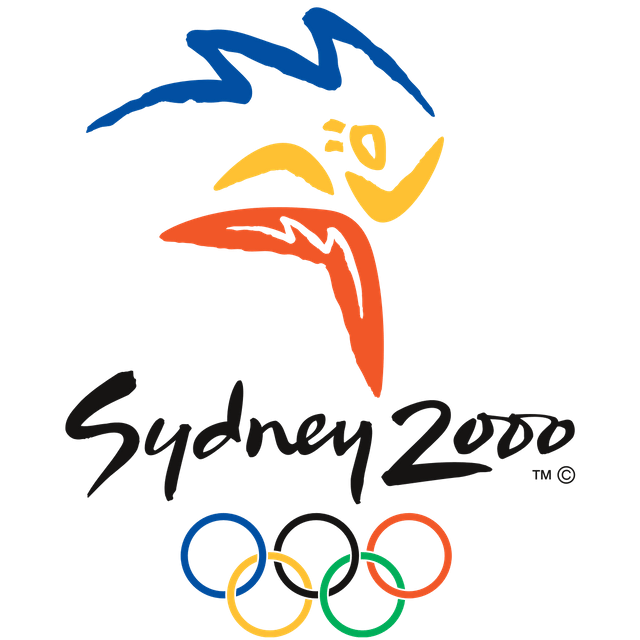
2000 Summer Olympics

| Host city | Sydney, New South Wales, Australia | ||
|---|---|---|---|
| Motto | Share the Spirit | ||
| Nations | 199 | ||
| Athletes | 10,651 (6,582 men, 4,069 women)[2] | ||
| Events | 300 in 28 sports (40 disciplines) | ||
| Opening | 15 September | ||
| Closing | 1 October | ||
| Opened by | Governor-General Sir William Deane[3] | ||
| Cauldron | Cathy Freeman[3] | ||
| Stadium | Stadium Australia | ||
| Summer | |||
| |||
| Winter | |||
| |||
The 2000 Summer Olympic Games, officially known as the Games of the XXVII Olympiad and commonly known as Sydney 2000 or the Millennium Olympic Games/Games of the New Millennium, were an international multi-sport event which was held between 15 September and 1 October 2000 in Sydney, New South Wales, Australia. It was the second time that the Summer Olympics were held in Australia, and also the Southern Hemisphere, the first being in Melbourne, Victoria, in 1956.
The final medal tally was led by the United States, followed by Russia and China with host Australia at fourth place overall. Several World and Olympic records were broken during the games. With little or no controversies, the games were deemed generally successful with the rising standard of competition amongst nations across the world.
| Host city | Sydney, New South Wales, Australia | ||
|---|---|---|---|
| Motto | Share the Spirit | ||
| Nations | 199 | ||
| Athletes | 10,651 (6,582 men, 4,069 women)[2] | ||
| Events | 300 in 28 sports (40 disciplines) | ||
| Opening | 15 September | ||
| Closing | 1 October | ||
| Opened by | Governor-General Sir William Deane[3] | ||
| Cauldron | Cathy Freeman[3] | ||
| Stadium | Stadium Australia | ||
| Summer | |||
| |||
| Winter | |||
| |||
Host city selection
Sydney won the right to host the Games on 24 September 1993, after being selected over Beijing, Berlin, Istanbul and Manchester in four rounds of voting, at the 101st IOC Session in Monte Carlo, Monaco. The Australian city of Melbourne had lost out to Atlanta for the 1996 Summer Olympics four years earlier.[4] Beijing lost its bid to host the games to Sydney in 1993, but was later awarded the 2008 Summer Olympics in July 2001 after Sydney hosted the previous year, and it would eventually be awarded the 2022 Winter Olympics twenty-two years later in 2015. Although it is impossible to know why members of the International Olympic Committee voted for Sydney over Beijing in 1993, it appears that an important role was played by Human Rights Watch's campaign to "stop Beijing" because of China's human rights record. Many in China were angry at what they saw as U.S.-led interference in the vote, and the outcome contributed to rising anti-Western sentiment in China and tensions in Sino-American relations.[5]
| 2000 Summer Olympics bidding results[6] | ||||||
|---|---|---|---|---|---|---|
| City | NOC Name | Round 1 | Round 2 | Round 3 | Round 4 | |
| Sydney | 30 | 30 | 37 | 45 | ||
| Beijing | 32 | 37 | 40 | 43 | ||
| Manchester | 11 | 13 | 11 | — | ||
| Berlin | 9 | 9 | — | — | ||
| Istanbul | 7 | — | — | — | ||
Costs
The Oxford Olympics Study 2016 estimates the outturn cost of the Sydney 2000 Summer Olympics at USD 5 billion in 2015-dollars and cost overrun at 90% in real terms.[7] This includes sports-related costs only, that is, (i) operational costs incurred by the organizing committee for the purpose of staging the Games, e.g., expenditures for technology, transportation, workforce, administration, security, catering, ceremonies, and medical services, and (ii) direct capital costs incurred by the host city and country or private investors to build, e.g., the competition venues, the Olympic village, international broadcast center, and media and press center, which are required to host the Games. Indirect capital costs are not included, such as for road, rail, or airport infrastructure, or for hotel upgrades or other business investment incurred in preparation for the Games but not directly related to staging the Games. The cost for Sydney 2000 compares with a cost of USD 4.6 billion for Rio 2016, USD 40–44 billion for Beijing 2008 and USD 51 billion for Sochi 2014, the most expensive Olympics in history. Average cost for the Summer Games since 1960 is USD 5.2 billion, average cost overrun is 176%.
In 2000, the Auditor-General of New South Wales reported that the Sydney Games cost A$6.6 billion, with a net cost to the public between A$1.7 and A$2.4 billion.[8][9] Many venues were constructed in the Sydney Olympic Park, which failed in the years immediately following the Olympics to meet the expected bookings to meet upkeep expenses.[10] In the years leading up to the games, funds were shifted from education and health programs to cover Olympic expenses.[11]
It has been estimated that the economic impact of the 2000 Olympics was that A$2.1 billion has been shaved from public consumption. Economic growth was not stimulated to a net benefit and in the years after 2000, foreign tourism to NSW grew by less than tourism to Australia as a whole. A "multiplier" effect on broader economic development is not realised, as a simple "multiplier" analysis fails to capture is that resources have to be redirected from elsewhere: the building of a stadium is at the expense of other public works such as extensions to hospitals. Building sporting venues does not add to the aggregate stock of productive capital in the years following the Games: "Equestrian centres, softball compounds and man-made rapids are not particularly useful beyond their immediate function."[12] In the years after the games, infrastructure issues have been of growing concern to citizens, especially those in the western suburbs of Sydney. Proposed rail links to Sydney's west have been estimated to cost in the same order of magnitude as the public expenditure on the games.
Chronological summary of the 2000 Summer Olympics
Preliminary matches – from 13 September
Although the Olympic Games Opening Ceremony was not scheduled until 15 September, the football competitions began with preliminary matches on 13 September. Among the pre-ceremony fixtures, host nation Australia lost 1–0 to Italy at the Melbourne Cricket Ground, which was the main stadium for the 1956 Melbourne Olympics.
Day 1–15 September
Cultural display highlights
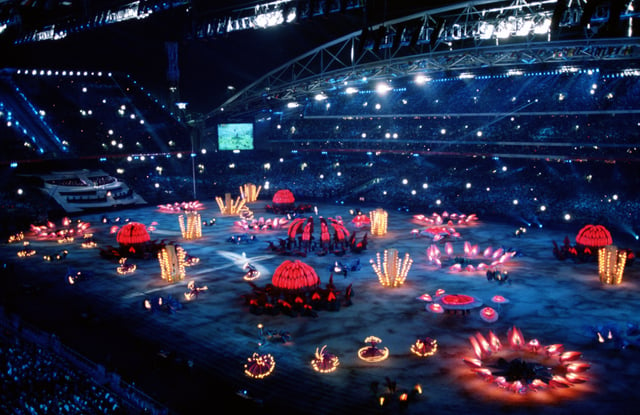
The 2000 Summer Olympics Opening Ceremony at Stadium Australia, on 15 September 2000.
The opening ceremony began with a tribute to the Australian pastoral heritage of the Australian stockmen and the importance of the stock horse in Australia's heritage. It was produced and filmed by Sydney Olympic Broadcasting Organisation and the home nation broadcaster, Channel 7.[13] This was introduced by a lone rider, Steve Jefferys, and his rearing Australian Stock Horse Ammo. At the cracking of Jefferys' stockwhip, a further 120 riders entered the Stadium, their stock horses performing intricate steps, including forming the five Olympic Rings, to a special Olympics version of the theme which Bruce Rowland had previously composed for the 1982 film The Man from Snowy River.
The Australian National Anthem was sung, the first verse by Human Nature and the second by Julie Anthony.
The ceremony continued, showing many aspects of the land and its people:- the affinity of the mainly coastal-dwelling Australians with the sea that surrounds the "Island Continent". The indigenous occupation of the land, the coming of the First Fleet, the continued immigration from many nations and the rural industry on which the economy of the nation was built, including a display representing the harshness of rural life based on the paintings of Sir Sidney Nolan. Two memorable scenes were the representation of the "Heart" of the country by 200 Aboriginal women from Central Australia who danced up "the mighty spirit of God to protect the Games" and the overwhelmingly noisy representation of the construction industry by hundreds of tap-dancing teenagers.
Because Bibi Salisachs (the wife of Juan Antonio Samaranch, the IOC President) was seriously ill and not able to accompany her husband to the Olympics, former Australian Olympic Champion swimmer and member of the Parliament of New South Wales, Dawn Fraser, accompanied Samaranch during the Australian cultural display, explaining to him some of the cultural references that are unfamiliar to non-Australians.
Formal presentation
A record 199 nations entered the stadium, with a record 80 of them winning at least one medal. The only missing IOC member was Afghanistan (banned due to the extremist rule of the Taliban's oppression of women and its prohibition of sports[14]). The ceremony featured a unified entrance by the athletes of North and South Korea,[1] using a specially designed unification flag: a white background flag with a blue map of the Korean Peninsula. Four athletes from East Timor also marched in the parade of nations as Individual Olympic Athletes and marched directly before the Host country. Although the country-to-be had no National Olympic Committee then, they were allowed to compete under the Olympic Flag with country code IOA. The Governor-General, Sir William Deane, opened the games.
The Olympic Flag was carried around the arena by eight former Australian Olympic champions: Bill Roycroft, Murray Rose, Liane Tooth, Gillian Rolton, Marjorie Jackson, Lorraine Crapp, Michael Wenden and Nick Green. During the raising of the Olympics Flag, the Olympic Hymn was sung by the Millennium Choir of the Greek Orthodox Archdiocese of Australia in Greek. Following this, Tina Arena sang a purpose-written pop song, The Flame.[15]
The opening ceremony concluded with the lighting of the Olympic Flame. Former Australian Olympic champion Herb Elliott brought the Olympic Flame into the stadium. Then, celebrating 100 years of women's participation in the Olympic Games, former Australian women Olympic medalists: Betty Cuthbert and Raelene Boyle, Dawn Fraser, Shirley Strickland (later Shirley Strickland de la Hunty), Shane Gould and Debbie Flintoff-King brought the torch through the stadium, handing it over to Cathy Freeman, who lit the flame in the cauldron within a circle of fire. The planned spectacular climax to the ceremony was delayed by the technical glitch of a computer switch which malfunctioned, causing the sequence to shut down by giving a false reading. This meant that the Olympic flame was suspended in mid-air for about four minutes, rather than immediately rising up a water-covered ramp to the top of the stadium. When the cause of the problem was discovered, the program was overridden and the cauldron continued its course, and the ceremony concluded with a spectacular fireworks display.[16]
Day 2–16 September
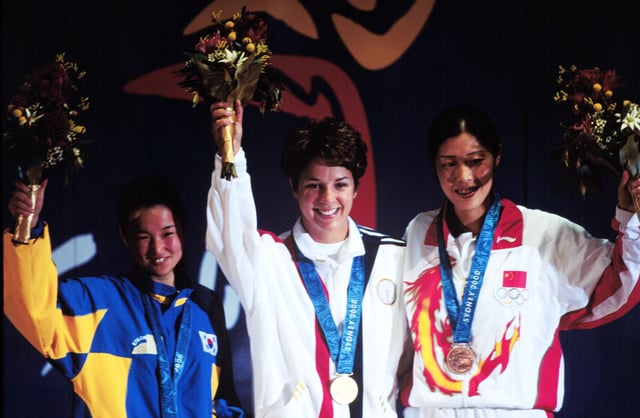
Gold medallist Nancy Johnson (centre) of the U.S., raises her hands with silver medallist Cho-Hyun Kang (left), of South Korea, and bronze winner Gao Jing (right), of China, during the first medal ceremony of the 2000 Olympic Games.
The first medals of the Games were awarded in the women's 10 metre air rifle competition, which was won by Nancy Johnson of the United States.
The Triathlon made its Olympic debut with the women's race. Set in the surroundings of the Sydney Opera House, Brigitte McMahon representing Switzerland swam, cycled and ran to the first gold medal in the sport, beating the favoured home athletes such as Michelie Jones who won silver. McMahon only passed Jones in sight of the finish line.
The first star of the Games was Ian Thorpe. The 17-year-old Australian first set a new world record in the 400 m freestyle final before competing in an exciting 4 × 100 m freestyle final. Swimming the last leg, Thorpe passed the leading Americans and arrived in a new world record time, two tenths of a second ahead of the Americans. In the same event for women, the Americans also broke the world record, finishing ahead of the Netherlands and Sweden.
Samaranch had to leave for home, as his wife was severely ill. Upon arrival, his wife had already died. Samaranch returned to Sydney four days later. The Olympic flag was flown at half-staff during the period as a sign of respect to Samaranch's wife.
Day 3–17 September
Canadian Simon Whitfield sprinted away in the last 100 metres of the men's triathlon, becoming the inaugural winner in the event.
On the cycling track, Robert Bartko beat fellow German Jens Lehmann in the individual pursuit, setting a new Olympic Record. Leontien Zijlaard-van Moorsel set a world record in the semi-finals the same event for women.
In the swimming pool, American Tom Dolan beat the world record in the 400 m medley, successfully defending the title he won in Atlanta four years prior. Dutchwoman Inge de Bruijn also clocked a new world record, beating her own time in the 100 m butterfly final to win by more than a second.
Day 4–18 September
The main event for the Australians on the fourth day of the Games was the 200 m freestyle. Dutchman Pieter van den Hoogenband had broken the world record in the semi-finals, taking it from the new Australian hero Ian Thorpe, who came close to the world record in his semi-final heat. As the final race finished, Van den Hoogenband's time was exactly the same as in the semi-finals, finishing ahead of Thorpe by half a second.
China won the gold medal in the men's team all-around gymnastics competition, after being the runner-up in the previous two Olympics. The other medals were taken by Ukraine and Russia, respectively.
Zijlaard-van Moorsel lived up to the expectations set by her world record in cycling in the semis by winning the gold medal.
Day 7–21 September
Controversy erupted at the Women's Gymnastics All-Around final, when gymnast after gymnast fell on the vault. Some gymnasts were physically injured, and all were shaken, but nothing was done to try to discover the reason most gymnasts were having severe problems. Finally, in the middle of the third round (out of four), it was determined that the vault horse had been set 5 cm too low – enough of a difference to throw off the impeccable timing of many of these world-class athletes. While athletes were allowed to vault again, the remedy did not fully repair injuries and shaken confidence. The medals were eventually all won by Romanian gymnasts, with Andreea Raducan becoming the first athlete from her country to win the title since Nadia Comaneci in 1976. Teammates Simona Amanar and Maria Olaru took silver and bronze, respectively. This result also marked the first sweep of the event since the Soviet Union's in 1960.
Day 9–23 September
By rowing in the winning coxless four, Steve Redgrave of Great Britain became a member of a select group who had won gold medals at five consecutive Olympics.
The swimming 4 x 100-metre medley relay of B.J. Bedford, Megan Quann (Jendrick), Jenny Thompson and Dara Torres became the first women's relay under 4-minutes, swimming 3:58 and setting a world record, claiming the gold medal for the United States.
Day 10–24 September
Rulon Gardner, never a NCAA champion or a world medalist, beat Alexander Karelin of Russia to win gold in the super heavyweight class, Greco-Roman wrestling. Karelin had won gold in Seoul, Barcelona and Atlanta. Before this fight he had never lost in international competition, had been unbeaten in all competitions in 13 years, and had not surrendered a point in a decade.
Day 11–25 September
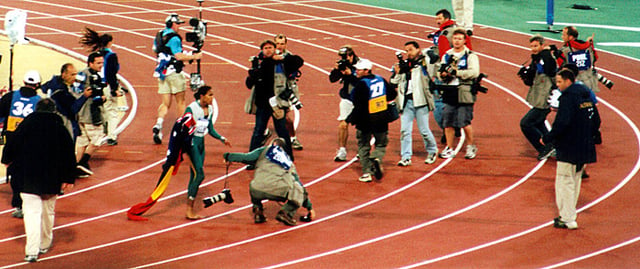
Cathy Freeman after the 400 metre final
Australian Cathy Freeman won the 400 metre final in front of a jubilant Sydney crowd at the Olympic Stadium, ahead of Lorraine Graham of Jamaica and Katharine Merry of Great Britain. Freeman's win made her the first competitor in Olympic Games history to light the Olympic Flame and then go on to win a Gold Medal. The attendance at the stadium was 112,524 – the largest attendance for any sport in Olympic Games history.
In a men's basketball pool match between the USA and France, the USA's Vince Carter made one of the most famous dunks in basketball history. After getting the ball off a steal, the 6'6"/1.98 m Carter drove to the basket, with 7'2"/2.18 m centre Frédéric Weis in his way. Carter jumped, spread his legs in midair, scraped Weis' head on the way up, and dunked. The French media dubbed the feat le dunk de la mort ("the dunk of death").
Day 14–28 September
The Canadian flag at athletes' village is lowered to half-staff as Canadian athletes pay tribute to former prime minister Pierre Trudeau after hearing of his death in Montreal (Because of the time difference, it was 29 September in Sydney when Trudeau died). The Canadian flag flew at half-staff for the remainder of the Olympics, on orders from both IOC President Juan Antonio Samaranch and Canadian Foreign Affairs Minister Lloyd Axworthy, as the state funeral did not take place until 3 October.
Day 16–30 September
Day 17–1 October
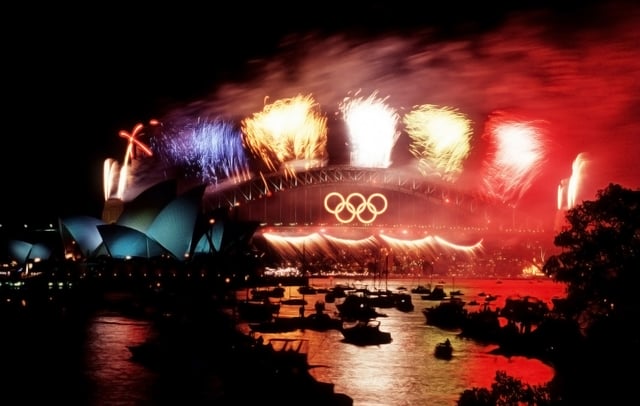
Olympic colours on the Sydney Harbour Bridge.
The last event of the games was the Men's Marathon, contested on a course that started in North Sydney. The event was won by Ethiopian Genzhnge Abera, with Eric Wananina second and Tesefe Tola, also of Ethiopia third. It was the first time since the 1968 Olympics that an Ethiopian had won the gold medal in this event.
The Closing Ceremony commenced with Christine Anu singing her version of the Warumpi Band's song, My Island Home. She performed with several Aboriginal dancers atop the Geodome Stage in the middle of the stadium, around which several hundred umbrella and lampbox kids created an image of Aboriginal dreamtime.
The Geodome Stage was used throughout the ceremony, which is a flat stage which is mechanically raised into the shape of a Geode.
IOC President Juan Antonio Samaranch declared at the Closing Ceremony,[18]
I am proud and happy to proclaim that you have presented to the world the best Olympic Games ever.
Subsequent Summer Olympics held in Athens, Beijing and London have been described by Samaranch's successor, Jacques Rogge, as "unforgettable, dream Games", "truly exceptional" and "happy and glorious games" respectively – the practice of declaring games the "best ever" having been retired after the 2000 games.
The Olympic Hymn was sung by soprano Yvonne Kenny. The ceremony also featured performing artists such as Jimmy Barnes, INXS, Midnight Oil, Kylie Minogue, Slim Dusty, Christine Anu, Nikki Webster, John Paul Young, Men at Work, Melbourne-based singer Vanessa Amorosi, Tommy Emmanuel, and pop duo Savage Garden.
The Games were then handed over to their modern birthplace, Athens, which succeeded Sydney as summer Olympic host city. Two Greek flags were raised; one to honour the birthplace of the Olympics, and the other to honour Athens. The ceremony concluded with a huge fireworks display on Sydney Harbour. The fireworks display itself concluded with a very low flyover of Stadium Australia by an RAAF F-111C which performed a dump-and-burn manoeuvre synchronised with the extinction of the Olympic Flame. This created the appearance of the flame being carried away into the sky, flying in a northeasterly direction out across Sydney Harbour and ultimately towards Athens in a symbolic handover.
In honour of her gold medal win during the games, Cathy Freeman represented Oceania in carrying the Olympic flag, joining Archbishop Desmond Tutu (Africa), John Glenn (The Americas), Kazuyoshi Funaki (Asia), Lech Wałęsa (Europe), Jean-Michel Cousteau (Environment), Jean-Claude Killy (Sport), and Steven Spielberg (Culture) when it was raised again, at the XIX Olympic Winter Games in Salt Lake City; the opening ceremony there took place on 8 February 2002.
Sports
The 2000 Summer Olympic programme featured 300 events in the following 28 sports:
Although demonstration sports were abolished following the 1992 Summer Olympics the Sydney Olympics featured wheelchair racing as exhibition events on the athletics schedule.[19]
Special quarantine conditions were introduced to allow entry of horses into Australia to participate in equestrian events,[20] avoiding the need for such events to take place elsewhere as had happened at the 1956 Summer Olympics in Melbourne.
Calendar
| ● | Opening ceremony | Event competitions | ● | Event finals | ● | Closing ceremony |
| Date | September | October | |||||||||||||||||
|---|---|---|---|---|---|---|---|---|---|---|---|---|---|---|---|---|---|---|---|
| 13th Wed | 14th Thu | 15th Fri | 16th Sat | 17th Sun | 18th Mon | 19th Tue | 20th Wed | 21st Thu | 22nd Fri | 23rd Sat | 24th Sun | 25th Mon | 26th Tue | 27th Wed | 28th Thu | 29th Fri | 30th Sat | 1st Sun | |
| Archery | ● | ● | ● | ● | |||||||||||||||
| Athletics | ● ● | ● ● | ● ● ● ● ● ● | ● ● ● ● ● ● ● ● ● | ● ● ● ● ● ● ● | ● ● ● ● ● ● | ● ● ● ● ● | ● ● ● ● ● ● ● ● | ● | ||||||||||
| Badminton | ● ● | ● | ● ● | ||||||||||||||||
| Baseball | ● | ||||||||||||||||||
| Basketball | ● | ● | |||||||||||||||||
| Boxing | ● ● ● ● ● ● | ● ● ● ● ● ● | |||||||||||||||||
| Canoeing | ● ● | ● ● | ● ● ● ● ● ● | ● ● ● ● ● ● | |||||||||||||||
| Cycling | ● ● | ● ● | ● | ● | ● ● ● | ● ● ● | ● | ● | ● | ● | ● ● | ||||||||
| Diving | ● ● | ● | ● | ● ● ● | ● | ||||||||||||||
| Equestrian | ● | ● | ● | ● | ● | ● | |||||||||||||
| Fencing | ● | ● | ● | ● | ● | ● ● | ● | ● ● | |||||||||||
| Field hockey | ● | ● | |||||||||||||||||
| Football | ● | ● | |||||||||||||||||
| Gymnastics | ● | ● | ● | ● | ● | ● | ● ● ● ● ● | ● ● ● ● ● | ● | ● | |||||||||
| Handball | ● | ● | |||||||||||||||||
| Judo | ● ● | ● ● | ● ● | ● ● | ● ● | ● ● | ● ● | ||||||||||||
| Modern pentathlon | ● | ● | |||||||||||||||||
| Rowing | ● ● ● ● ● ● ● | ● ● ● ● ● ● ● | |||||||||||||||||
| Sailing | ● ● ● | ● | ● ● | ● ● | ● ● ● | ||||||||||||||
| Shooting | ● ● | ● ● | ● ● | ● ● | ● ● | ● ● ● | ● ● | ● ● | |||||||||||
| Softball | ● | ||||||||||||||||||
| Swimming | ● ● ● ● | ● ● ● ● | ● ● ● ● | ● ● ● ● | ● ● ● ● | ● ● ● ● | ● ● ● ● | ● ● ● ● | |||||||||||
| Synchronized swimming | ● | ● | |||||||||||||||||
| Table tennis | ● | ● | ● | ● | |||||||||||||||
| Taekwondo | ● ● | ● ● | ● ● | ● ● | |||||||||||||||
| Tennis | ● ● | ● ● | |||||||||||||||||
| Triathlon | ● | ● | |||||||||||||||||
| Volleyball | ● | ● | ● | ● | |||||||||||||||
| Water polo | ● | ● | |||||||||||||||||
| Weightlifting | ● | ● ● | ● ● | ● ● | ● ● | ● ● | ● | ● | ● | ● | |||||||||
| Wrestling | ● ● ● ● | ● ● ● ● | ● ● ● ● | ● ● ● ● | |||||||||||||||
| Total gold medals | 13 | 14 | 15 | 15 | 18 | 18 | 18 | 26 | 25 | 18 | 11 | 17 | 17 | 11 | 40 | 24 | |||
| Ceremonies | ● | ● | |||||||||||||||||
| Date | 13th Wed | 14th Thu | 15th Fri | 16th Sat | 17th Sun | 18th Mon | 19th Tue | 20th Wed | 21st Thu | 22nd Fri | 23rd Sat | 24th Sun | 25th Mon | 26th Tue | 27th Wed | 28th Thu | 29th Fri | 30th Sat | 1st Sun |
| September | October | ||||||||||||||||||
Medal count
| Rank | Nation | Gold | Silver | Bronze | Total |
|---|---|---|---|---|---|
| 1 | 37 | 24 | 32 | 93 | |
| 2 | 32 | 28 | 29 | 89 | |
| 3 | 28 | 16 | 15 | 59 | |
| 4 | 16 | 25 | 17 | 58 | |
| 5 | 13 | 17 | 26 | 56 | |
| 6 | 13 | 14 | 11 | 38 | |
| 7 | 13 | 8 | 13 | 34 | |
| 8 | 12 | 9 | 4 | 25 | |
| 9 | 11 | 11 | 7 | 29 | |
| 10 | 11 | 10 | 7 | 28 | |
| Totals (10 nations) | 186 | 162 | 161 | 509 | |
* Host nation (Australia)
Participating National Olympic Committees

Participating countries
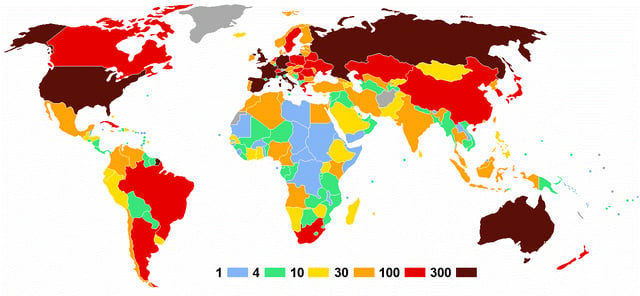
Number of athletes
199 National Olympic Committees (NOCs) participated in the Sydney Games, two more than in the 1996 Summer Olympics. In addition, there were four Timorese Individual Olympic Athletes at the 2000 Summer Olympics. Eritrea, Federated States of Micronesia and Palau made their Olympic debut this year.
Afghanistan was the only 1996 participant that did not participate in 2000, having been banned due to the extremist rule of the Taliban's oppression of women and its prohibition of sports.
| Participating National Olympic Committees |
|---|
|
Venues
Sydney Olympic Park
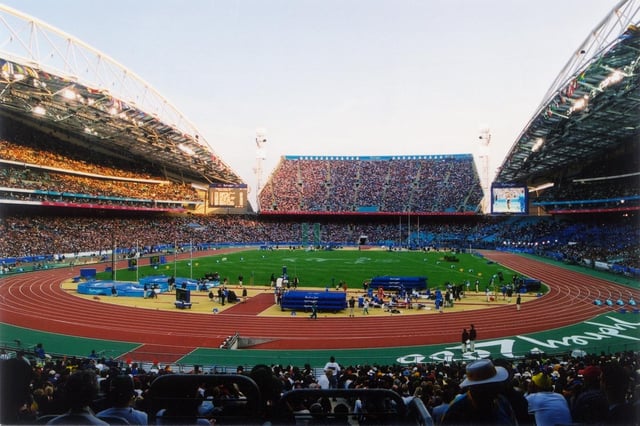
Olympic Stadium
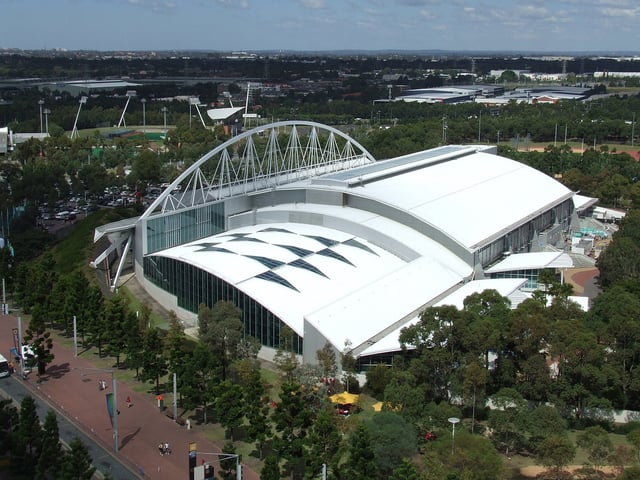
Sydney Olympic Park Aquatic Centre

State Hockey Centre
Olympic Stadium: Ceremonies (opening/closing), Athletics, Football (final)
Sydney International Aquatic Centre: Diving, Modern Pentathlon (swimming) Swimming, Synchronised Swimming, Water Polo (medal events)
State Sports Centre: Table Tennis, Taekwondo
NSW Tennis Centre: Tennis
State Hockey Centre: Field Hockey
The Dome and Exhibition Complex: Badminton, Basketball, Gymnastics (rhythmic), Handball (final), Modern Pentathlon (fencing, shooting), Volleyball (indoor)
Sydney SuperDome: Gymnastics (artistic, trampoline), Basketball (final)
Sydney Baseball Stadium: Baseball, Modern Pentathlon (riding, running)
Sydney International Archery Park: Archery
Sydney

Dunc Gray Velodrome
Sydney Convention and Exhibition Centre: Boxing, Fencing, Judo, Weightlifting, Wrestling
Sydney Entertainment Centre: Volleyball (indoor final)
Dunc Gray Velodrome: Cycling (track)
Sydney International Shooting Centre: Shooting
Sydney International Equestrian Centre: Equestrian
Sydney International Regatta Centre: Rowing, Canoeing (sprint)
Blacktown Olympic Centre: Baseball, Softball
Western Sydney Parklands: Cycling (mountain biking)
Ryde Aquatic Leisure Centre: Water Polo
Penrith Whitewater Stadium: Canoeing (slalom)
Bondi Beach: Volleyball (beach)
Sydney Football Stadium: Football
Olympic Sailing Shore Base: Sailing
Centennial Parklands: Cycling (road)
Marathon course: Athletics (marathon)
North Sydney: Athletics (marathon start)
Sydney Opera House: Triathlon
Outside Sydney
Organisation
Organisations responsible for the Olympics
A number of quasi-government bodies were responsible for the construction, organisation and execution of the Sydney Games. These included:
the Sydney Organising Committee for the Olympic Games (SOCOG), primarily responsible for the staging of the Games
Olympic Coordination Authority (OCA), primarily responsible for construction and oversight
Olympic Roads & Transport Authority (ORTA)
Olympic Security Command Centre (OSCC)
Olympic Intelligence Centre (OIC)
JTF Gold the Australian Defence Force Joint Taskforce Gold
Sydney Olympic Broadcasting Organisation (nominally part of SOCOG)
IBM, provider of technology and the Technical Command Centre
Telstra, provider of telecommunications
Great Big Events, event management and marketing
These organisations worked closely together and with other bodies such as:
the International Olympic Committee (IOC)
the Australian Olympic Committee (AOC)
the other 197 National Olympic Committees (NOCs)
the 33 International Sports Federations (IFs)
all three levels of Australian government (federal, state and local)
dozens of official sponsor and hundreds of official supplier companies
These bodies are often collectively referred to as the "Olympic Family".
Organisation of the Paralympics
Organisation of the 2000 Summer Paralympics was the responsibility of SPOC the Sydney Paralympic Organising Committee. However much of the planning and operation of the Paralympic Games was outsourced to SOCOG such that most operational programmes planned both the Olympic and Paralympic Games.
Other Olympic events
Organisation of the Games included not only the actual sporting events but also the management (and sometimes construction) of the sporting venues and surrounding precincts, the organisation of the Sydney Olympic Arts Festival and Olympic torch relay. The relay began in Greece and travelled to Australia via numerous Oceania island nations.
Phases of the Olympic project
The staging of the Olympics were treated as a project on a vast scale, with the project broken into several broad phases:
1993 to 1996 – positioning
1997 – going operational
1998 – procurement/venuisation
1999 – testing/refinement
2000 – implementation
2001 – post implementation and wind-down
SOCOG organisational design
The internal organisation of SOCOG evolved over the phases of the project and changed, sometimes radically, several times.
In late 1998 the design was principally functional. The top two tiers below the CEO Sandy Hollway consisted of five groups (managed by Group General Managers and the Deputy CEO) and twenty divisions (managed by divisional General Managers), which in turn were further broken up into programmes and sub-programmes or projects.
In 1999 functional areas (FAs) broke up into geographic precinct and venue teams (managed by Precinct Managers and Venue Managers) with functional area staff reporting to both the FA manager and the venue manager. Ie, SOCOG moved to a matrix structure. The Interstate Football division extant in 1998 was the first of these geographically based venue teams.
Volunteer programme
The origins of the volunteer programme for Sydney 2000 dates back to the bid, as early as 1992.
On 17 December 1992, a group of Sydney citizens, interested in the prospect of hosting the 2000 Olympic and Paralympic Games, gathered for a meeting at Sports House, at Wentworth Park in Sydney.
In the period leading up to 1999, after Sydney had won the bid, the small group of volunteers grew from approximately 42 to around 500. These volunteers became known as Pioneer Volunteers. The Pioneer Volunteer programme was managed internally by SOCOG's Volunteer Services Department in consultation with prominent peak groups like The Centre for Volunteering (Volunteering and TAFE. Some of the Pioneer Volunteers still meet every four months, an unseen legacy of the games which brought together a community spirit not seen before.
Marketing
The official logo
The bid logo, designed by architect and designer Michael Bryce,[25] featured a colourful, stylised image of the Sydney Opera House.
The official logo – also referred to as the "Millennium Man"[26] – took the image of the bid logo and combined it with a stylised image of a runner to form a torchbearer in motion; formed by two small yellow boomerangs for arms and a larger red boomerang for legs. The Olympic torch is represented through a blue smoke trail, which draws the iconic peaks of the Sydney Opera House.
The design process of the official logo, as well as all other aspects of the Olympic Games' visual design identity, was awarded to Melbourne design studio FHA Image Design.[27] The Sydney Olympics brand identity project officially commenced in 1993.
The Mascots
The official mascots chosen for the 2000 Summer Olympics were Syd the platypus, Millie the echidna, and Olly the kookaburra[28] and were designed by Matthew Hattan and Jozef Szekeres and named by Philip Sheldon of agency Weekes Morris Osborn in response to the original SOCOG recommendation of Murray, Margery and Dawn after famous Australian athletes.
Sponsors
Medals and bouquets
The bouquets handed to medal recipients incorporated foliage from the Grevillea baileyana, also known as the white oak.[34]
Awards and commendations
The International Olympic Committee awarded Sydney and its inhabitants with the "Pierre de Coubertin Trophy" in recognition of the collaboration and happiness shown by the people of Sydney during the event to all the athletes and visitors around the world.[35]
The New South Wales Police Force was granted use of the Olympic Rings in the New South Wales Police Force Olympic Commendation and the New South Wales Police Force Olympic Citation for having staged the "safest" games ever.
Broadcast rights
Argentina: Azul TV, TyC Sports, TyC Max, TyC Max 2, Multideporte 74, TeleRed Sports 1, TeleRed Sports 2, TeleRed Sports 3, Multicanal, BAC (Buenos Aires and Metropolitan zone only), Supercanal (Interior zone only)
Australia: Seven Network, C7
Austria: ORF
Belgium: VRT, RTBF
Brazil: Rede Globo, Rede Bandeirantes, SporTV, ESPN Brasil
Brunei: RTB, Astro
Canada: CBC Radio-Canada
Chile: Televisión Nacional de Chile (TVN), Mega, Canal 13
China: CCTV
Colombia: RCN Televisión, Channel 11
Croatia: HRT
Czech Republic: ČT
Ecuador: SíTV
Europe: Eurosport
FR Yugoslavia: RTS, RTCG
Germany: ARD, RTL, ZDF
Greece: ERT
Hong Kong: ATV, TVB
Hungary: Magyar Televízió
India: Doordarshan
Indonesia: RCTI, SCTV, TPI, ANTeve, Indosiar, MetroTV (transmission test)
Ireland: RTÉ
Italy: RAI
Japan: NHK, Fuji Television
Latin America: TNT, ESPN, Fox Sports and PSN
Lithuania: LRT
Macau: TDM
Macedonia: MKRTV
Malaysia: RTM, STMB, Mega TV, Philips ASTRO
Netherlands: NPO, RTL5
New Zealand: TVNZ
Norway: NRK
Paraguay: El 13, Tigo Sports, Tigo Max, Tigo Max 2, Multideportes 67, CVC Sports 1, CVC Sports 2, CVC Sports 3, Multicanal, CMM (Asunción and Metropolitan zone only), Supercanal (Interior zone only)
Peru: Panamericana Televisión, CMD, CMD 2
Philippines: PTV 4, SkyCable
Poland: TVP
Romania: TVR
Russia: Public Russian Television, VGTRK Olympiade
Singapore: TCS SportsCity
South Korea: KBS, MBC, SBS
Spain: TVE
Sri Lanka: Rupavahini (SLRC)
Sweden: SVT
Switzerland: SRG SSR idee suisse
Taiwan: TTV, CTV, CTS
Thailand: National Sports
Turkey: TRT
United Kingdom: BBC, ITV
United States: NBC
Uruguay: Canal 10, VTV Sports, Multicanal, Cablevisión, TCC Cable Television and Equital Cable Television system
Venezuela: Venevision
In popular culture
In F.J. Campbell's 2018 novel No Number Nine, the last part of the book is set at the Sydney 2000 Olympics.[36]
In Tom Clancy's thriller Rainbow Six, the 2000 Olympic Games are the setting of a plot by eco-terrorists, who plan to use the games in order to spread a terrible new plague throughout the world.[37]
In Morris Gleitzman's children's book Toad Rage, a cane toad travels to Sydney in a bid to become the Olympic mascot.[38]
See also
2000 Summer Paralympics
Olympic Games celebrated in Australia 1956 Summer Olympics – Melbourne 2000 Summer Olympics – Sydney
Summer Olympic Games
International Olympic Committee
List of IOC country codes
The Games of the XXVII Olympiad 2000: Music from the Opening Ceremony
Aussie Aussie Aussie, Oi Oi Oi
John Coates
Use of performance-enhancing drugs in the Olympic Games — Sydney 2000